Hello everyone!
Two weeks ago I bought a Sony a5100 with 16-50 lenses (Model SELP1650), but when I started filming I noticed shadows around the image.
I researched forums about the problem, and saw that it could be an effect called 'vignette'.
I shoot with the setting 1/80 F5.6 and ISO around 400 to 600 (with 3 lamps of 60w in a room of 3 meters by 3 meters)
and I was recommended to set the camera to 1/60 F11 and a higher ISO (around 2000)
I put this setting, but with the ISO increased, the image is very saturated.
Is there any other solution to remove these shadows?
The camera is very good, and the focus is fast, but this problem with "shadows" (or "vignettes") is putting an end to my filming.
The image below is part of a shot on a white wall
Configurations: 1/80 F5.6 and ISO around 400 to 600 (with 3 60w lamps in a 3 meter by 3 meter room)
Two weeks ago I bought a Sony a5100 with 16-50 lenses (Model SELP1650), but when I started filming I noticed shadows around the image.
I researched forums about the problem, and saw that it could be an effect called 'vignette'.
I shoot with the setting 1/80 F5.6 and ISO around 400 to 600 (with 3 lamps of 60w in a room of 3 meters by 3 meters)
and I was recommended to set the camera to 1/60 F11 and a higher ISO (around 2000)
I put this setting, but with the ISO increased, the image is very saturated.
Is there any other solution to remove these shadows?
The camera is very good, and the focus is fast, but this problem with "shadows" (or "vignettes") is putting an end to my filming.
The image below is part of a shot on a white wall
Configurations: 1/80 F5.6 and ISO around 400 to 600 (with 3 60w lamps in a 3 meter by 3 meter room)


